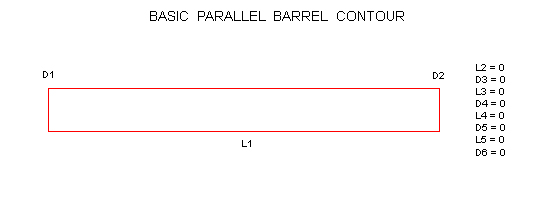
|
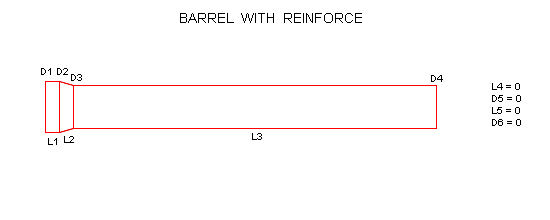
|
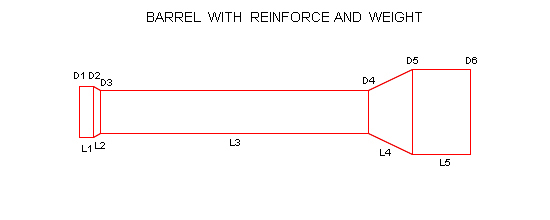
|
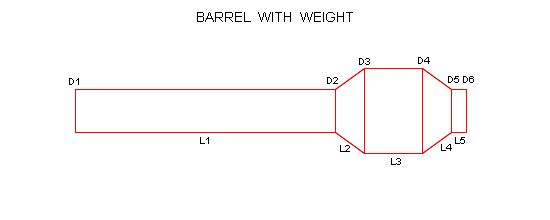
|
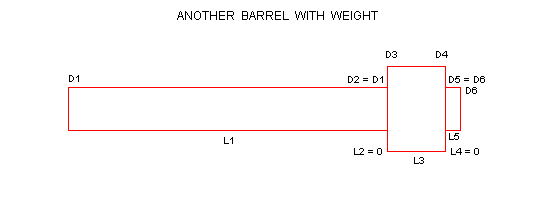
|
This is a powerful and flexible program, but the usual rule applies - garbage in, garbage out.
READ THE TEXT AT THE BOTTOM OF THE PAGE TO ENSURE YOU GET USEFUL RESULTS
|
What this program does
The program is a virtual finite element "lumped parameter" model of a rifle barrel which simulates the transverse vibrations in a rifle barrel. The transverse vibrations are due to the recoil forces in the rifle imparting a moment on the back of the barrel as the rifle rotates about its centre of gravity. The way in which the barrel vibrates with time depends mainly on the dimensions of the barrel. The amplitude the barrel vibrations will depend on the weight of the whole rifle and the distance of the Centre of Gravity of the rifle from the bore-line of the barrel. This program allows you to enter the weight of your rifle of interest, and the distance from the C of G of the rifle to the bore-line, and the various dimensions of the barrel. Thus, you can create a virtual model of your particular rifle and see how the vibrations of the barrel will affect the fall of shot.
Using the program A rifle weight of 11 lb (5kg) and a distance of one inch (25.4mm) for the Centre of Gravity distance below the boreline assumed in the absence of any entered values. Finding the weight of your rifle is relatively easy, but the distance of the Centre of Gravity of the rifle from the bore line is trickier to measure. After the "Calculate" button is pressed, an image of a barrel with the entered dimensions will be created. It should be noted that the scale for the barrel radius is expanded relative to the barrel length, making the image of the barrel look fore-shortened compared to the actual barrel. A graph of the variation of the angle of the muzzle to the horizontal with time is given. This angle determines the trajectory of the bullet and so where it will strike on the target. The barrel dimension fields can be varied and a re-calculation done to see how the change in barrel dimensions affect the vibrations.
Limitations and Accuracy Barrel length must be more than 4" (100mm) and less than 35" (900mm). Barrel diameters must not be more than 2" (50mm). The barrel is assumed to be round. Barrel dimensions that approach these dimensional limits may result in instabilities in the program which give rise to "strange" results. If you change a particular dimension gradually and there is a sudden change in the predicted vibration, this will most probably be due to an instability in the program. The muzzle angle shown in the graph is only approximate as the actual value will depend on a number of factors which are difficult to model. Varying the parameters of the model will show how the amplitude will vary, however. For the purposes of modelling the barrel, the barrel is divided up into a number of short "Finite Elements" such that the length of each element is around 0.8" (20mm). Small changes in overall barrel length will be accurately modelled as changing the barrel length just results in a small change in the length of each element. However, the position of any abrupt change in barrel diameter (say, where a weight is put on the barrel) cannot be modelled with a resolution of much better than an element length. This means that the program will not accurately follow any changes in the position of a barrel weight or tuner (say) if the change is less than around 0.8" (20m). In practice, small changes in the position of weights or tuners on the barrels of centerfire rifles do not have much effect on the barrel vibrations, so this is of little consequence. The model assumes that the rifle is essentially in free space and unconstrained by any rests or clamps as it recoils. Shooting a rifle off bags is a fair approximation to this. However, if small calibre rifle is gripped tightly or pulled hard into the shoulder then the recoil dynamics could be affected. The model assumes that the stock and other parts of the rifle are "stiff" and do not contribute to the vibrations themselves. However, it is assumed that the action will not be stiff and to model this, a section is added to the back of the barrel which is 4" (100mm) long and 1.5" (38mm) diameter, with a bore of 1" (25.4mm). In high power centerfire rifles, this would appear to be a reasonable approximation. This added section is for modelling purposes only and does not appear in the drawing of the barrel created from the given barrel dimensions. No account is taken in this model of the interaction of the bullet travelling up the barrel with the barrel vibrations. The program was created initially to try and understand the vibrations on barrels of rimfire rifles. It turned out that the pressure-time curve for the tiny rimfire cartridge is too short for the consequent vibrations to be modelled successfully by a model of this sort, and vibrations from other sources would appear to be significant in rimfire rifle barrels which are not modelled here. However, it would seem that the much longer pressure-time curve of larger calibre centre-fire rifles, and the much higher recoil, mean that this model can be successfully used for such rifles. It should be emphasised that this model is not suitable for rimfire rifles.
Why this program was developed Knowing when the bullet exits the barrel is, of course, fairly critical in determining how the muzzle is changing in angle at this moment in time. The time it takes for the bullet to travel the length of the barrel will be dependent on the cartridge type and barrel length; and is usually between 1.0 and 1.5 milliseconds. There are programs such as QuickLoad which can predict a potentially more accurate value for the barrel exit time. Steady state standing wave analytic solutions to the equation of motion for transverse vibrations on beams are often held up as "how rifle barrels vibrate". But in truth, the phase velocities of these transverse vibrations are too slow (compared to the bullet passage time in the barrel) to allow these standing waves to develop during the period of interest. What is required is a numerical model which simulates how a rifle barrel reacts dynamically to the impulsive moment applied to its back end due to the recoil forces. Commercially available "Finite Element Analysis" computer programs that are able to model such events are usually used by car makers to simulate how their latest model will crumple when it hits a bridge or another car, or designers of sky scrapers to see what would happen if an aircraft crashed into their latest design. Consequently, such programs are prohibitively expensive. But the complexity of the generalised 3D meshes used in such programs is probably not required. Great simplification can be achieved by using a one dimensional array of elements to model the rifle barrel, without significant reduction in accuracy of the resulting dynamic behaviour. In consequence, development of this model for simulating barrel vibrations was started in December 2010 as one arm of an effort to understand the dynamics of a rifle under recoil. The other arm is to actually measure the barrel vibrations in order to verify the theoretical model underpinning this program.
|

|

|

|

|

|